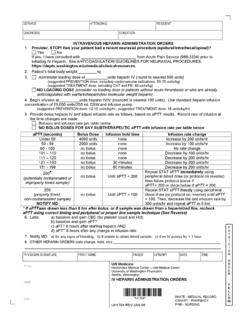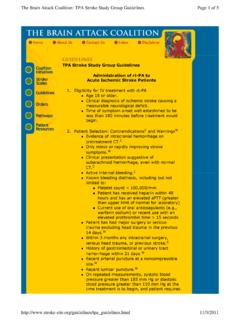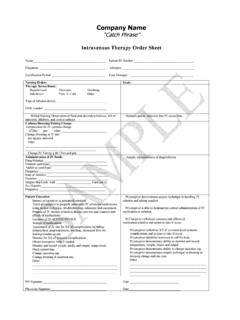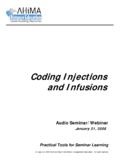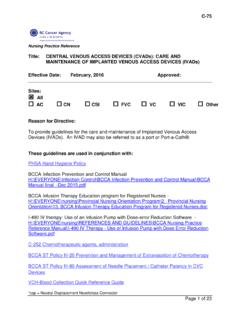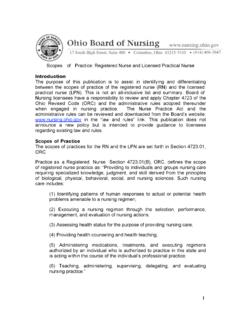Transcription of Title: CENTRAL VENOUS ACCESS DEVICES (CVAD): CARE …
1 C-80. Nursing Practice Reference title : CENTRAL VENOUS ACCESS DEVICES ( cvad ): CARE AND. MAINTENANCE OF TUNNELED (T- cvad ) AND NON-TUNNELED (NT- cvad ) CATHETERS. Effective Date: February, 2016 Approved: Sites: All AC CN CSI FVC VC VIC Other Reason for Directive: To provide guidelines for the care and maintenance of CENTRAL VENOUS ACCESS DEVICES (CVADs), both: tunneled or long term (Hickman / Broviac) and non-tunneled, percutaneous, or short term. These guidelines are used in conjunction with: PHSA Hand Hygiene Policy BCCA Infection Prevention and Control Manual H:\EVERYONE\Infection Control\BCCA Infection Prevention and Control Manual\BCCA.
2 Manual final -Dec BCCA Infusion Therapy Education program for Registered Nurses - H:\EVERYONE\nursing\Provincial Nursing Orientation Program\2. Provincial Nursing Orientation\13. BCCA Infusion Therapy Education Program for Registered I-490 IV therapy: Use of an Infusion Pump with Dose-error Reduction Software - H:\EVERYONE\nursing\REFERENCES AND GUIDELINES\BCCA Nursing Practice Reference Manual\I-490 IV Therapy - Use of Infusion Pump with Dose Error Reduction C-252 Chemotherapeutic agents, administration *cap = Neutral Displacement Needleless Connector Page 1 of 27. C-80. BCCA ST Policy III-20 Prevention and Management of Extravasation of Chemotherapy BCCA ST Policy III-80 Assessment of Needle Placement / Catheter Patency in CVC.
3 DEVICES VCH-Blood Collection Quick Reference Guide H:\EVERYONE\nursing\EDUCATION CENTRAL VENOUS ACCESS DEVICES - Naturopathic Doctors: CENTRAL VENOUS ACCESS DEVICES : Naturopathic Doctor Position Statement H:\EVERYONE\nursing\EDUCATION\ CENTRAL VENOUS ACCESS DEVICES - Naturopathic Doctors\Naturopathic Doctor Position Patient handout: Naturopathic Doctor- Use of CENTRAL VENOUS ACCESS DEVICES FAQ. H:\EVERYONE\nursing\EDUCATION\ CENTRAL VENOUS ACCESS DEVICES - Naturopathic Doctors\Naturopathic Doctors - CENTRAL VENOUS ACCESS DEVICES *cap = Neutral Displacement Needleless Connector Page 2 of 27. C-80.
4 Index Page(s). DIRECTIVES. Clinical Competency Validation 4. Patient Education 4. Features: Tunneled / Non-Tunneled, Single / multi-lumen, Valved / non- 4. valved, Power Capable DEVICES Insertion/Removal: Suture Removal 5. Documentation and Reporting: Type of cvad , Care, PSLS 5. Infection Prevention and Control: Sterile Aseptic Technique, 3-swab-no- 6. touch-technique, Catheter Site Assessment and Cleansing Dressings 7. Infusion Equipment 7. Preventing Air Embolism 8. Maintaining Patency: Pulsatile and Positive Pressure technique 8. cvad Damage 9. PROCEDURES. Routine Flush, Lock and Cap change 9.
5 Initiating an Infusion 10. Completing an Infusion 11. Drawing Blood Specimens 12. Dressing Change 14. MANAGEMENT OF POTENTIAL CATHETER OCCLUSION PARTIAL 15. AND COMPLETE. Standard Trouble-Shooting Process 15. Management of an Occluded cvad with Alteplase 16. Skin Patch Test 18. REFERENCES 19. APPENDIX A: 21. Patient Information Handout *cap = Neutral Displacement Needleless Connector Page 3 of 27. C-80. DIRECTIVES: Clinical Competency Validation: The Registered Nurse (RN) / student nurse must have completed the BCCA Infusion Therapy Education Program for RNs and subsequent skill validation in order to perform any procedure on a cvad .
6 Patient Education: To include schedule for care and management, role in self-care, signs, symptoms and potential for infection and occlusion and when, how and to whom to report changes. Standard BCCA materials related to self-care of CVADs will be used. Patient Information Handout for CVADs is located in Appendix A. Features: Tunneled (T- cvad ) vs Non - Tunneled (NT- cvad ) see BCCA Infusion Therapy Education Program Single or Multi-Lumen: Each lumen of a multi-lumen cvad is treated as a separate catheter. Recommend that where possible, the largest (gauge) lumen be used for blood sampling, blood product administration, and administration of viscous or high volume fluids.
7 Valved: A valve is present near the distal tip of the catheter. Clamps will NOT be present on external portion of catheter. Non-valved: The catheter is open at the distal tip. Requires clamping before entry into, or exit out of, the system. Power Capable CVADs: Routine care according to the procedures in this document apply to power capable CVADs. No special care needs, unless they are being used for diagnostic purposes. Special tubing required to withstand the higher intraluminal pressures generated during power injection. NB: If cvad is unfamiliar, contact the manufacturer's clinical support line to determine device care or obtain device policy from the insertion facility.
8 *cap = Neutral Displacement Needleless Connector Page 4 of 27. C-80. Insertion/Removal: T-CVADs and NT- CVADs must be inserted by a physician. The catheter tip is ideally located in the junction between the superior vena cava (SVC) and the right atrium. Confirmation of tip placement by X-ray or fluoroscopy is done at time of catheter insertion. In an emergency situation, confirmation of NT- cvad placement by X-ray is waived. CVADs are usually removed by a physician when Therapy is completed The catheter is malpositioned The tip is no longer within the SVC. The catheter is damaged The patient has developed a catheter-related infection.
9 Sutures: T- cvad - Sutures may be located at: Vein entrance site (neck): Sutures may be dissolvable or non-dissolvable. Dissolvable sutures are not visible on the skin: you will see a knot only. Non-dissolvable sutures/staples are removed 7 days post T- cvad insertion. Exit Site (chest): Suture is removed 14 days post T- cvad insertion. Exception: If bruising is present, remove suture 14 days after bruising subsides. If patient is on steroids or has had recent radiation therapy to the chest, leave suture until physician orders suture removal (may be up to 4-6 weeks). NT- cvad sutures remain in situ for the lifetime of the catheter.
10 Documentation and Reporting: Type of cvad : The first nurse, prior to ACCESS of an cvad is responsible for documenting the following on the ALERT form in the patient record: Date of insertion Type of device Valved, or non-valved Need for heparin The source of the information ( operative report or the patient's wallet card). *cap = Neutral Displacement Needleless Connector Page 5 of 27. C-80. Documentation of Care: All procedures performed on a cvad will be documented using the appropriate documentation forms and includes, but is not limited to: Condition of the site, type of dressing and catheter stabilization.










